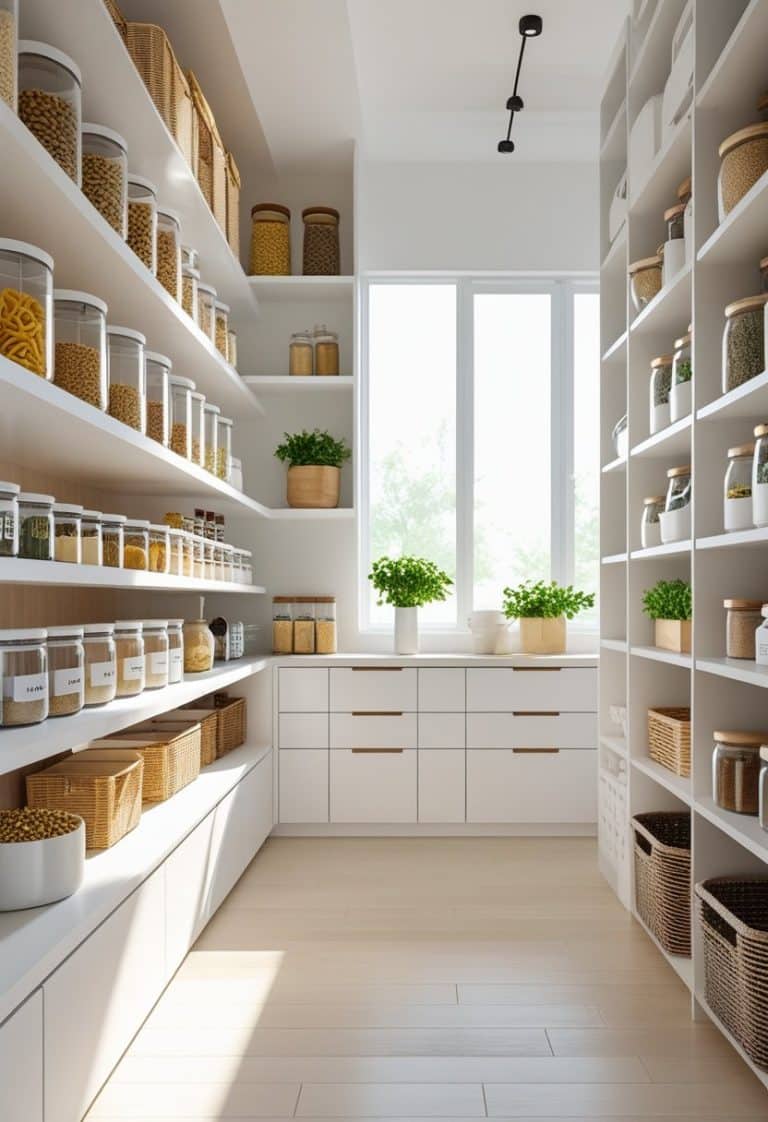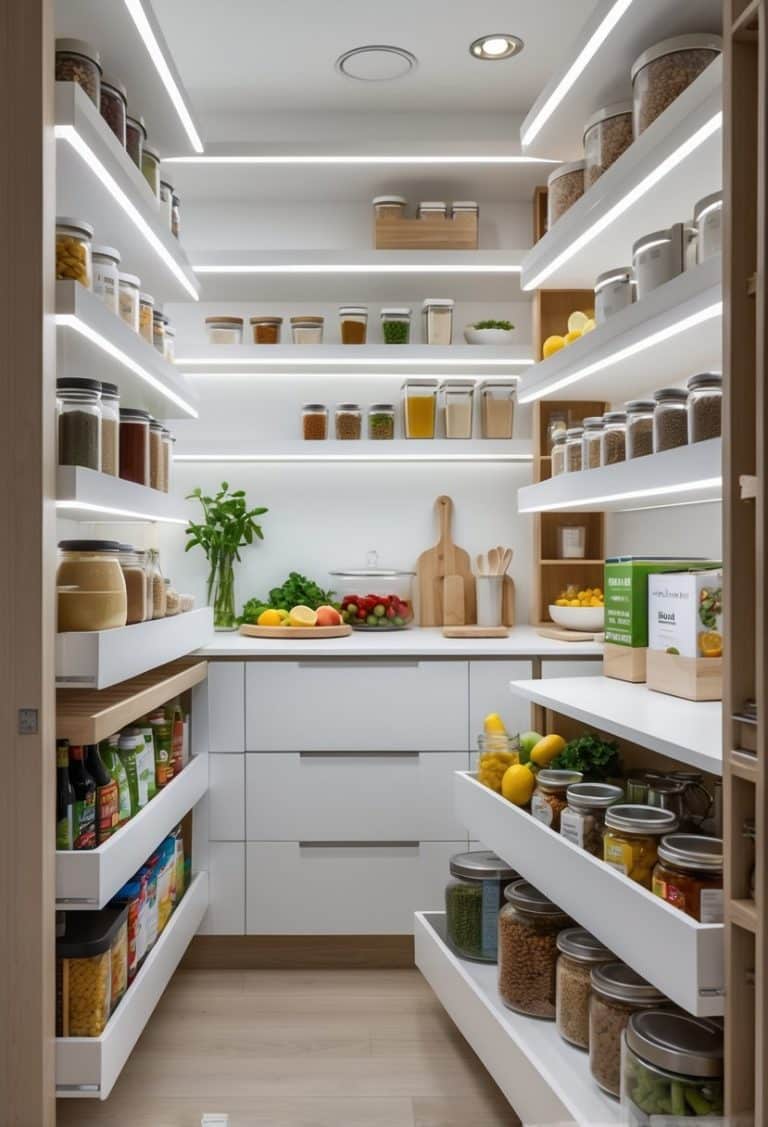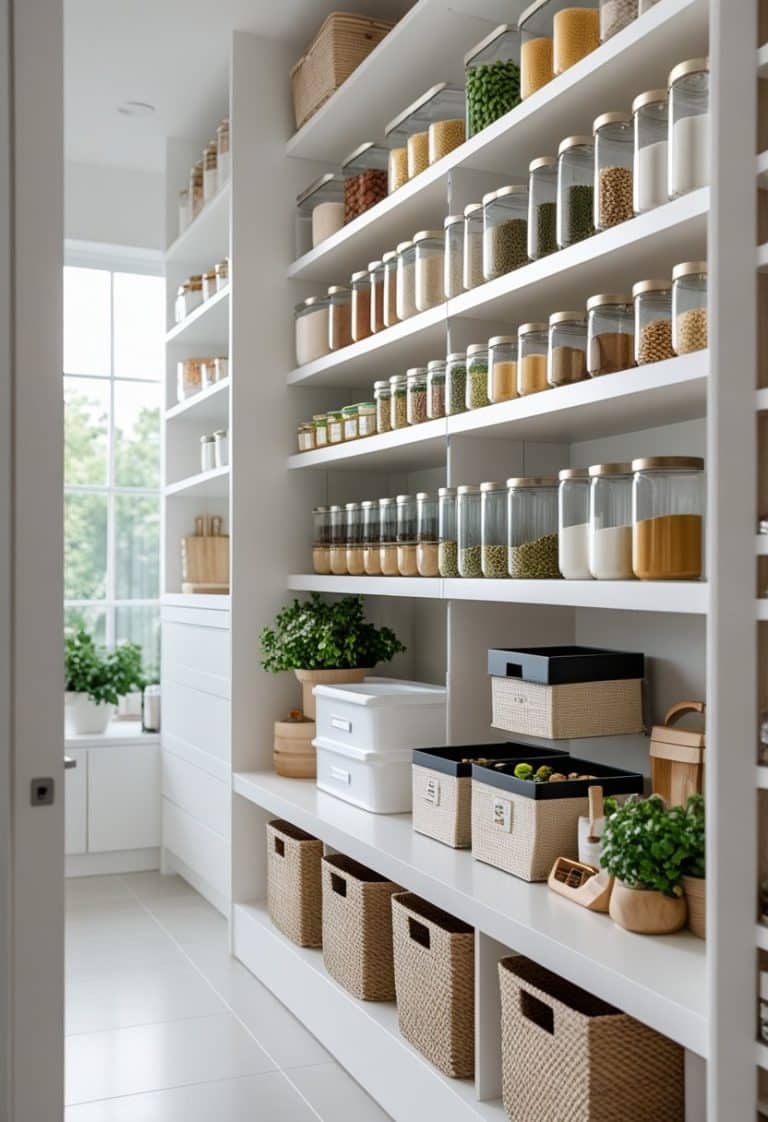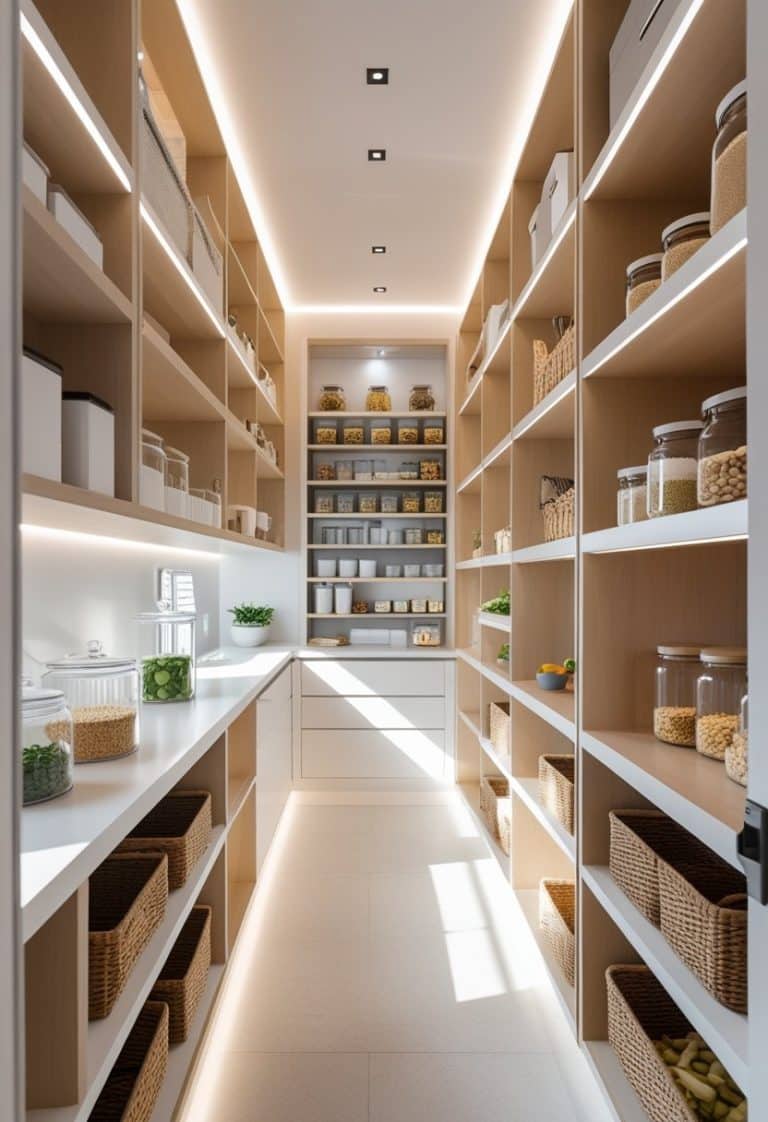Hidden Pantry Ideas 2026: 22 Smart Ways To Maximize Kitchen Storage
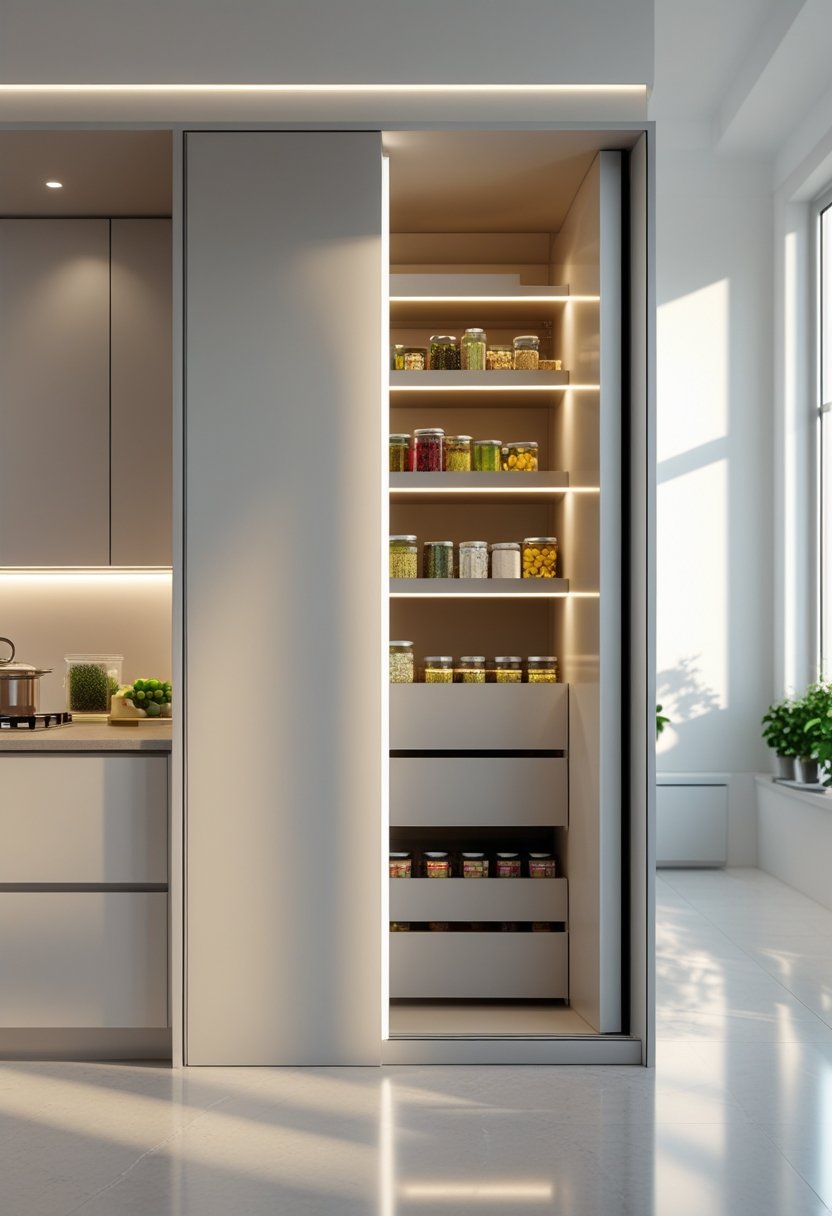
Hidden pantry designs continue to grow in popularity as kitchens evolve toward cleaner lines and smarter layouts. They allow a space to stay organized without sacrificing style or function. A hidden pantry offers a seamless way to keep essentials close while maintaining a polished, uncluttered kitchen.

By 2026, new design ideas highlight how concealed storage can fit any home size or layout. From creative door disguises to integrated cabinetry and modern automation, these innovations show how thoughtful design can make storage both practical and visually cohesive.
Hidden pantry behind deep green cabinetry with brass hardware

This hidden pantry blends into deep green cabinetry accented with brass hardware. The design keeps storage space out of sight while maintaining a cohesive look.
When closed, the pantry appears as part of the cabinets. When opened, it reveals organized shelving that maximizes space without interrupting the kitchen’s clean design.
Walk-in pantry with pocket door for space saving

A walk-in pantry with a pocket door helps save floor space in smaller kitchens. The door slides into the wall, leaving more room for movement and storage.
This design works well in narrow layouts where a swinging door would block access or create clutter. It keeps the pantry accessible and organized.
Secret pantry door disguised as a bookshelf

A bookshelf door hides the pantry behind a wall of books or decorative items. It blends with the room’s design, keeping storage areas out of sight.
This type of hidden door often uses sturdy hinges and smooth hardware to open easily while maintaining the look of real shelving.
Pantry Concealed Behind a Sliding Barn Door

A sliding barn door hides the pantry while adding a simple design feature. It moves smoothly along a track, saving space compared to a swinging door.
This option fits both rustic and modern kitchens. Matching the door’s color or finish to nearby cabinets helps it blend naturally with the room’s style.
Under-stair hidden pantry storage

Under-stair hidden pantries use space that often goes unused. They fit neatly under the staircase and can store dry goods, small appliances, or cleaning supplies.
Designers often add sliding or hinged doors that match nearby walls or cabinets. This keeps the area looking clean while adding practical storage.
Pantry integrated into kitchen island compartments

Hidden storage within a kitchen island helps keep essentials close without cluttering the space.
Designers often use sliding drawers or lift-up panels to store dry goods or small appliances.
This approach works well in compact kitchens where every inch of space needs to serve multiple purposes.
Automated hidden pantry with motorized doors

An automated hidden pantry uses motorized doors that open and close with a button, sensor, or remote.
These systems keep the pantry concealed within the kitchen design while offering quick access.
Motorized doors work well in modern homes, combining convenience with a clean, seamless look.
Pantry hidden behind mirrored cabinet doors

A pantry hidden behind mirrored cabinet doors helps small kitchens look larger and brighter. The mirrors reflect light, creating a sense of space without changing the layout.
This design keeps storage organized and discreet while maintaining a clean, modern look that blends with surrounding cabinetry.
Pull-out pantry shelves concealed within cabinetry

Pull-out pantry shelves fit neatly behind cabinet doors, keeping storage hidden and organized.
They slide out smoothly, giving full access to items without wasted space.
This design works well in both small and large kitchens, offering a clean look while improving accessibility and efficiency.
Pantry door flush with wall paneling for seamless look

A pantry door that sits flush with wall paneling creates a clean and continuous surface. It helps the pantry blend into the surrounding design, keeping the kitchen uncluttered.
This approach works well in modern and minimalist spaces where subtle details support a streamlined appearance.
Hidden pantry with frosted glass door

A hidden pantry with a frosted glass door keeps storage discreet while allowing soft light to pass through.
The frosted finish blurs the view inside, helping the pantry blend with modern kitchen designs.
This style works well for small or open kitchens that need both privacy and brightness.
Pantry Disguised as a Pantry-Shaped Artwork Panel

A pantry disguised as an artwork panel blends storage with design. The door looks like a decorative wall piece but opens to reveal shelves and supplies.
This approach keeps the kitchen looking clean and uncluttered. It works well in modern or eclectic spaces that value both function and subtle creativity.
Corner pantry with concealed bi-fold doors

A corner pantry with concealed bi-fold doors saves space and keeps the kitchen design clean.
The folding doors open wide, allowing easy access to stored items without blocking walkways.
When closed, the doors blend with surrounding cabinets, maintaining a seamless and organized look in the kitchen.
Pantry hidden behind a chalkboard or message board

A pantry hidden behind a chalkboard or message board keeps storage out of sight while adding function to the kitchen wall.
The chalkboard surface lets users write grocery lists or notes without taking extra space.
This design works well in small kitchens, blending practicality with a simple, clean look.
Pantry concealed behind a full-height pantry cabinet

A full-height pantry cabinet hides storage space behind doors that blend with the rest of the kitchen cabinetry.
This design keeps the kitchen looking neat and unified while offering easy access to shelves and supplies.
It works well in modern kitchens that value clean lines and practical organization.
Walk-in pantry with smart lighting and adjustable shelves

A walk-in pantry with smart lighting helps users see items clearly and saves energy. Motion sensors or LED strips under shelves provide even light across all areas.
Adjustable shelves let homeowners change spacing to fit different container sizes. This flexibility keeps storage efficient and organized as needs change.
Hidden pantry with magnetic push-to-open doors

A hidden pantry with magnetic push-to-open doors keeps the kitchen design clean and simple. The doors open with a light press, removing the need for handles or knobs.
This design blends the pantry into surrounding cabinets, creating a smooth, modern look while maintaining easy access to stored items.
Pantry Concealed Behind a Retractable Wall Panel

A retractable wall panel hides the pantry behind a smooth, matching surface. When closed, it blends with the surrounding wall or cabinetry for a clean look.
The panel slides or folds back easily to reveal organized storage space. This design works well in modern kitchens that value both function and simplicity.
Pantry door that blends with kitchen tile backsplash

A pantry door that matches the kitchen tile backsplash creates a clean, unified look.
Designers often align tile patterns or colors so the door appears as part of the wall.
This approach works well in modern kitchens, where subtle transitions and hidden storage keep the space tidy and visually balanced.
Pantry hidden behind a large kitchen appliance panel

A hidden pantry can sit behind a panel that matches large kitchen appliances like a refrigerator or oven wall.
This design keeps the kitchen looking uniform while offering easy access to storage.
The panel opens smoothly, revealing shelves or drawers that hold dry goods and small appliances.
Pantry with secret latch behind a decorative wall panel

A pantry hidden behind a decorative wall panel keeps the kitchen design clean and simple. The latch blends into the design, making the door nearly invisible.
This setup works well with modern or minimalist interiors. It adds storage without interrupting the visual flow of the space.
Hidden pantry with integrated spice rack inside door

A hidden pantry with an integrated spice rack inside the door combines storage and convenience. It keeps spices within easy reach while maintaining a clean, seamless look.
Designers often use Murphy-style or custom cabinetry doors to conceal the pantry. This setup maximizes space and helps organize kitchen essentials efficiently.
Optimizing Small Spaces for Hidden Pantries

Designers use compact layouts, smart shelving, and concealed doors to make small kitchens more functional. Efficient planning helps homeowners gain extra storage without expanding the footprint or disrupting the room’s style.
Creative Storage Solutions
Small kitchens benefit most from vertical storage and custom shelving. Adjustable shelves let users fit containers of different sizes, while pull-out drawers improve access to items stored in the back.
Using the inside of cabinet doors for spice racks or cleaning supply hooks adds hidden storage. Narrow pull-out pantries between appliances or beside refrigerators make use of unused gaps.
A quick reference for space-saving features:
| Feature | Benefit |
|---|---|
| Pull-out drawers | Easier access to deep shelves |
| Vertical shelving | Uses full wall height |
| Door storage | Keeps small items organized |
Clear containers and labels also help maintain order, reducing clutter and making it easy to find ingredients.
Integrating Hidden Pantries Into Existing Layouts
When adding a hidden pantry to an existing kitchen, designers often disguise it behind cabinet doors, sliding panels, or pocket doors. These features blend with the cabinetry, keeping the space cohesive.
Under-stair or corner areas can become compact walk-ins with built-in lighting and narrow shelving. In open layouts, a concealed pantry wall can separate zones without adding bulk.
Homeowners planning renovations can route electrical outlets inside pantry walls for small appliances. Soft-close hardware and matching finishes help maintain a seamless look while improving daily usability.
These strategies let small kitchens include hidden storage that feels intentional and efficient rather than added as an afterthought.
Design Considerations for Modern Hidden Pantries

Modern hidden pantries focus on seamless design, efficient storage, and durable finishes that match the rest of the kitchen. They rely on thoughtful layout planning and practical material choices to create a clean, cohesive, and functional space that remains discreet when closed.
Blending With Contemporary Interiors
A hidden pantry should look like part of the kitchen rather than a separate room. Designers often use flush cabinet fronts, handle-free doors, and matching finishes to achieve this effect. Concealed hinges and touch-latch systems help maintain smooth surfaces and uninterrupted lines.
Lighting plays an important role. Recessed LED strips inside shelving or under cabinets provide visibility without drawing attention to the pantry entrance. Soft, neutral lighting complements modern interiors and highlights key storage zones.
Color consistency is essential. Matching the pantry door’s color and texture to nearby cabinetry keeps the design unified. In open-concept layouts, using the same flooring and trim inside the pantry helps it feel like a natural extension of the kitchen.
Key integration features:
| Element | Function |
|---|---|
| Concealed door panels | Maintain seamless look |
| Consistent finishes | Create visual continuity |
| Recessed lighting | Improve visibility |
Choosing the Right Materials and Finishes
Hidden pantries need materials that balance durability with visual harmony. Common choices include laminate, painted wood, and matte lacquer for doors and shelving. These surfaces resist wear and are easy to clean, which suits high-use areas.
For countertops, designers often select quartz or solid surface materials that match the main kitchen workspace. This creates a unified appearance and simplifies maintenance.
Hardware should stay minimal. Slim handles or push-to-open mechanisms preserve the hidden effect while offering everyday practicality.
Moisture resistance matters, especially if the pantry stores appliances or a small sink. Using sealed finishes and proper ventilation prevents damage over time.
Recommended finishes:
- Matte or satin for a modern, low-glare look
- Neutral tones like white, gray, or light oak
- Durable coatings that resist heat and stains

